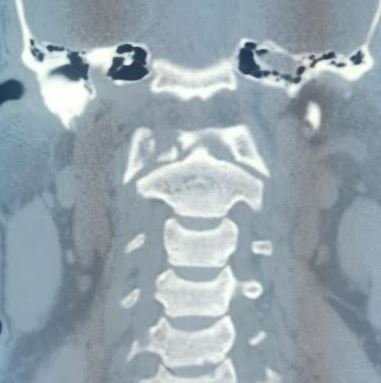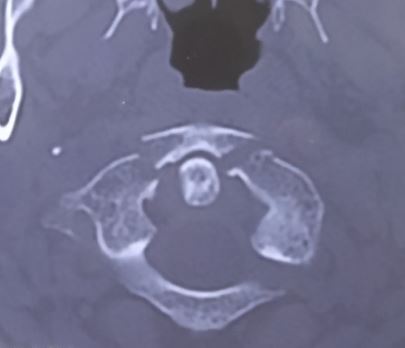[3]
Lyons JG,Mian HM, Epidemiology of atlas fractures in the United States: A 20-year analysis. Journal of craniovertebral junction
[PubMed PMID: 35386248]
[4]
Fiedler N,Spiegl UJA,Jarvers JS,Josten C,Heyde CE,Osterhoff G, Epidemiology and management of atlas fractures. European spine journal : official publication of the European Spine Society, the European Spinal Deformity Society, and the European Section of the Cervical Spine Research Society. 2020 Oct;
[PubMed PMID: 32002697]
[5]
Cloney MB,El-Tecle N,Dahdaleh NS, Traumatic atlas fracture patients comprise two subpopulations with distinct demographics and mechanisms of injury. Clinical neurology and neurosurgery. 2022 Aug 17;
[PubMed PMID: 35987045]
[6]
Matthiessen C,Robinson Y, Epidemiology of atlas fractures--a national registry-based cohort study of 1,537 cases. The spine journal : official journal of the North American Spine Society. 2015 Nov 1
[PubMed PMID: 26133259]
Level 3 (low-level) evidence
[7]
Ylönen H,Danner N,Jyrkkänen HK,Kämäräinen OP,Leinonen V,Huttunen J, Surgically Treated C1 Fractures: A Population-Based Study. World neurosurgery. 2021 Oct;
[PubMed PMID: 34284160]
[8]
Laubach M,Pishnamaz M,Scholz M,Spiegl U,Sellei RM,Herren C,Hildebrand F,Kobbe P, Interobserver reliability of the Gehweiler classification and treatment strategies of isolated atlas fractures: an internet-based multicenter survey among spine surgeons. European journal of trauma and emergency surgery : official publication of the European Trauma Society. 2022 Feb;
[PubMed PMID: 32918554]
Level 3 (low-level) evidence
[9]
Payabvash S,McKinney AM,McKinney ZJ,Palmer CS,Truwit CL, Screening and detection of blunt vertebral artery injury in patients with upper cervical fractures: the role of cervical CT and CT angiography. European journal of radiology. 2014 Mar
[PubMed PMID: 24355656]
[10]
Ma W,Xu N,Hu Y,Li G,Zhao L,Sun S,Jiang W,Liu G,Gu Y,Liu J, Unstable atlas fracture treatment by anterior plate C1-ring osteosynthesis using a transoral approach. European spine journal : official publication of the European Spine Society, the European Spinal Deformity Society, and the European Section of the Cervical Spine Research Society. 2013 Oct;
[PubMed PMID: 23775293]
[11]
Kandziora F,Scholz M,Pingel A,Schleicher P,Yildiz U,Kluger P,Pumberger M,Korge A,Schnake KJ,Spine Section of the German Society for Orthopaedics and Trauma., Treatment of Atlas Fractures: Recommendations of the Spine Section of the German Society for Orthopaedics and Trauma (DGOU). Global spine journal. 2018 Sep;
[PubMed PMID: 30210964]
[12]
Eun J,Oh Y, The relationship between radiologic parameters and transverse atlantal ligament injury obtained from MRI scans in patients with an isolated atlas burst fracture: A retrospective observational study. Medicine. 2021 Dec 10;
[PubMed PMID: 34889272]
Level 2 (mid-level) evidence
[13]
Lin P,Chuang TC,Baker JF, C1:C2 ratio is a potential tool assessing atlas fracture displacement and transverse ligament injury. Journal of craniovertebral junction
[PubMed PMID: 31772425]
[14]
Cloney M,Kim H,Riestenberg R,Dahdaleh NS, Risk Factors for Transverse Ligament Disruption and Vertebral Artery Injury Following an Atlas Fracture. World neurosurgery. 2021 Feb;
[PubMed PMID: 33309644]
[15]
Rusconi A,Peron S,Roccucci P,Stefini R, The internal carotid artery and the atlas: anatomical relationship and implications for C1 lateral mass fixation. Surgical and radiologic anatomy : SRA. 2021 Jan;
[PubMed PMID: 32734343]
[16]
Tomaszewski R,Sesia SB,Studer D,Rutz E,Mayr JM, Conservative treatment and outcome of upper cervical spine fractures in young children: A STROBE-compliant case series. Medicine. 2021 Apr 2;
[PubMed PMID: 33787631]
Level 2 (mid-level) evidence
[17]
Starnoni D,Ecker T,Barges-Coll J, Navigation-Assisted Posterior Open Reduction and Internal Fixation in a C-CLAMP Fashion for an Isolated C1 Fracture. Journal of neurological surgery. Part B, Skull base. 2021 Feb;
[PubMed PMID: 33692933]
[18]
Du YQ,Li T,Ma C,Qiao GY,Yin YH,Yu XG, Biomechanical evaluation of two alternative techniques to the Goel-Harms technique for atlantoaxial fixation: C1 lateral mass-C2 bicortical translaminar screw fixation and C1 lateral mass-C2/3 transarticular screw fixation. Journal of neurosurgery. Spine. 2020 Jan 17;
[PubMed PMID: 31952043]
Level 2 (mid-level) evidence
[19]
Conroy E,Laing A,Kenneally R,Poynton AR, C1 lateral mass screw-induced occipital neuralgia: a report of two cases. European spine journal : official publication of the European Spine Society, the European Spinal Deformity Society, and the European Section of the Cervical Spine Research Society. 2010 Mar;
[PubMed PMID: 19856190]
Level 3 (low-level) evidence
[20]
Butt BB,Gagnet P,Piche J,Patel R,Park P,Aleem IS, Lateral mass screw placement in the atlas: description of a novel surgical technique, radiographic parameters, and review of the literature. Journal of spine surgery (Hong Kong). 2021 Sep;
[PubMed PMID: 34734138]
[21]
Hu Y,Kepler CK,Albert TJ,Yuan ZS,Ma WH,Gu YJ,Xu RM, Accuracy and complications associated with the freehand C-1 lateral mass screw fixation technique: a radiographic and clinical assessment. Journal of neurosurgery. Spine. 2013 Apr;
[PubMed PMID: 23373564]
[22]
Rajasekaran S,Soundararajan DCR,Shetty AP,Kanna RM, Motion-Preserving Navigated Primary Internal Fixation of Unstable C1 Fractures. Asian spine journal. 2020 Aug;
[PubMed PMID: 32050311]
[23]
Barrenechea IJ,Márquez L,Bruna AE, Unilateral C1 split fracture osteosynthesis using a patient-specific three-dimensional-printed guide: Technique report. Journal of craniovertebral junction
[PubMed PMID: 35068828]
[24]
Wu C,Deng JY,Li T,Zeng BF,Hu HG,Zhu YF,Wei Q, 3D-Printed Screw-Rod Auxiliary System for Unstable Atlas Fractures: A Retrospective Analysis. Orthopaedic surgery. 2021 May;
[PubMed PMID: 33826254]
Level 2 (mid-level) evidence
[25]
Azimi P,Yazdanian T,Benzel EC,Aghaei HN,Azhari S,Sadeghi S,Montazeri A, Accuracy and safety of C2 pedicle or pars screw placement: a systematic review and meta-analysis. Journal of orthopaedic surgery and research. 2020 Jul 20;
[PubMed PMID: 32690035]
Level 1 (high-level) evidence
[26]
Zou X,Ouyang B,Ma X,Chen Y,Ge S,Zhang S,Ni L,Xia H,Wu Z, [Progress in treatment of unstable atlas fracture]. Zhongguo xiu fu chong jian wai ke za zhi = Zhongguo xiufu chongjian waike zazhi = Chinese journal of reparative and reconstructive surgery. 2020 Jun 15;
[PubMed PMID: 32538574]
[27]
Zou X,Ouyang B,Wang B,Yang H,Ge S,Chen Y,Ni L,Zhang S,Xia H,Wu Z,Ma X, Motion-preserving treatment of unstable atlas fracture: transoral anterior C1-ring osteosynthesis using a laminoplasty plate. BMC musculoskeletal disorders. 2020 Aug 12;
[PubMed PMID: 32787814]
[28]
Tu Q,Chen H,Li Z,Chen Y,Xu A,Zhu C,Huang X,Ma X,Wang J,Zhang K,Yin Q,Xu J,Xia H, Anterior reduction and C1-ring osteosynthesis with Jefferson-fracture reduction plate (JeRP) via transoral approach for unstable atlas fractures. BMC musculoskeletal disorders. 2021 Aug 30;
[PubMed PMID: 34461878]
[29]
Shin JW,Suk KS,Kim HS,Yang JH,Kwon JW,Lee HM,Moon SH,Lee BH,Park SJ,Park SR,Kim SK, Direct Internal Fixation for Unstable Atlas Fractures. Yonsei medical journal. 2022 Mar;
[PubMed PMID: 35184429]
[30]
Yan L,Du J,Yang J,He B,Hao D,Zheng B,Yang X,Hui H,Liu T,Wang X,Guo H,Chen J,Wang S,Ma S,Dong S, C1-ring osteosynthesis versus C1-2 fixation fusion in the treatment of unstable atlas fractures: a multicenter, prospective, randomized controlled study with 5-year follow-up. Journal of neurosurgery. Spine. 2022 Feb 11;
[PubMed PMID: 35148517]
Level 1 (high-level) evidence
[31]
Macki M,Hamilton T,Pawloski J,Chang V, Occipital fixation techniques and complications. Journal of spine surgery (Hong Kong). 2020 Mar;
[PubMed PMID: 32309653]
[32]
Bhimani AD,Chiu RG,Esfahani DR,Patel AS,Denyer S,Hobbs JG,Mehta AI, C1-C2 Fusion Versus Occipito-Cervical Fusion for High Cervical Fractures: A Multi-Institutional Database Analysis and Review of the Literature. World neurosurgery. 2018 Nov
[PubMed PMID: 30071333]
[33]
Purvis TE,De la Garza-Ramos R,Abu-Bonsrah N,Goodwin CR,Groves ML,Ain MC,Sciubba DM, External fixation and surgical fusion for pediatric cervical spine injuries: Short-term outcomes. Clinical neurology and neurosurgery. 2018 May
[PubMed PMID: 29505977]


